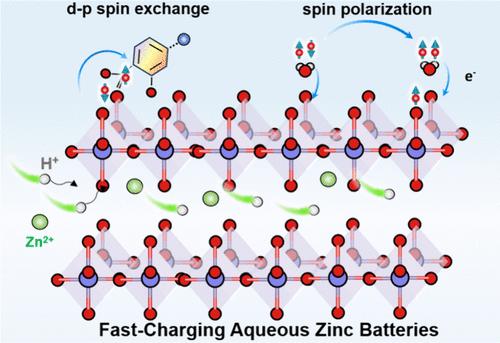Fast-Charging Aqueous Zinc Batteries Enabled by Enhanced O–H Bond Cleavage via d-p Spin Exchange Interactions
IF 18.2
1区 材料科学
Q1 CHEMISTRY, PHYSICAL
引用次数: 0
Abstract
Fast-charging aqueous zinc-ion batteries (ZIBs) are promising for sustainable energy storage; yet, precisely modulating proton (H+) intercalation and storage mechanisms remains challenging. Here, we present a cathode material composed of 4-fluorosalicylic acid (F–H2SA)-modified MnO2 (FSAMO), which exploits d-p spin exchange interactions to enhance H+ storage through facilitated O–H bond cleavage. We reveal that F–H2SA chemically bonds with MnO2, forming a Mn–O–O interface. The −COOH groups of F–H2SA induce spin polarization via d-p spin exchange interactions at this newly formed interface. Consequently, the induced spin polarization significantly accelerates electron exchange processes and promotes O–H bond breaking, thereby substantially improving H+ storage capacity in ZIBs. The FSAMO cathode achieves a remarkable capacity and practical application of 365 mAh g–1 at 0.3 A g–1. This study bridges fundamental spin chemistry and applied battery technology, offering a new approach to engineer cathode materials for ZIBs.

通过d-p自旋交换作用增强O-H键劈裂实现快速充电的水性锌电池
快速充电水性锌离子电池(zib)是一种有前景的可持续能源存储技术;然而,精确调节质子(H+)的插入和储存机制仍然具有挑战性。在这里,我们提出了一种由4-氟水杨酸(F-H2SA)修饰MnO2 (FSAMO)组成的阴极材料,它利用d-p自旋交换相互作用,通过促进O-H键的裂解来增强H+的储存。我们发现F-H2SA与MnO2化学键合,形成一个Mn-O-O界面。在这个新形成的界面上,F-H2SA的−COOH基团通过d-p自旋交换作用诱导自旋极化。因此,诱导的自旋极化显著加速了电子交换过程,促进了O-H键断裂,从而大大提高了ZIBs中H+的存储能力。FSAMO阴极在0.3 a g-1下实现了365 mAh g-1的卓越容量和实际应用。本研究将基础自旋化学与应用电池技术相结合,为ZIBs阴极材料的工程设计提供了新的途径。
本文章由计算机程序翻译,如有差异,请以英文原文为准。
求助全文
约1分钟内获得全文
求助全文
来源期刊

ACS Energy Letters
Energy-Renewable Energy, Sustainability and the Environment
CiteScore
31.20
自引率
5.00%
发文量
469
审稿时长
1 months
期刊介绍:
ACS Energy Letters is a monthly journal that publishes papers reporting new scientific advances in energy research. The journal focuses on topics that are of interest to scientists working in the fundamental and applied sciences. Rapid publication is a central criterion for acceptance, and the journal is known for its quick publication times, with an average of 4-6 weeks from submission to web publication in As Soon As Publishable format.
ACS Energy Letters is ranked as the number one journal in the Web of Science Electrochemistry category. It also ranks within the top 10 journals for Physical Chemistry, Energy & Fuels, and Nanoscience & Nanotechnology.
The journal offers several types of articles, including Letters, Energy Express, Perspectives, Reviews, Editorials, Viewpoints and Energy Focus. Additionally, authors have the option to submit videos that summarize or support the information presented in a Perspective or Review article, which can be highlighted on the journal's website. ACS Energy Letters is abstracted and indexed in Chemical Abstracts Service/SciFinder, EBSCO-summon, PubMed, Web of Science, Scopus and Portico.
 求助内容:
求助内容: 应助结果提醒方式:
应助结果提醒方式:


